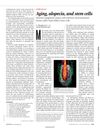Stem Cell Factor
aka - sh-Polypeptide-4
- SCF
- KIT-ligand
- steel factor
- mast cell growth factor
Stem Cell Factor (SCF) is an essential cytokine, a type of signaling protein, that plays a multitude of critical roles in human development and homeostasis. Also known by the names KIT-ligand (KL), steel factor, and mast cell growth factor, SCF is fundamental to the regulation of specific cell populations. The gene encoding this protein is located on chromosome 12q22-12q24 in humans. Through a process of alternative RNA splicing, this single gene gives rise to two distinct yet equally functional protein isoforms: a transmembrane form that remains anchored to the cell surface and a soluble form that is released to act on distant cells. Both forms are biologically active and exert their effects by binding to a specific cell surface receptor.
The primary mechanism of action for SCF is its interaction with the c-KIT receptor, a protein also known as CD117. This receptor is a transmembrane tyrosine kinase, meaning that when SCF binds to it, it triggers a cascade of phosphorylation events inside the cell, initiating complex signaling pathways that dictate cellular behavior. This SCF/c-Kit signaling axis is the master switch that controls the molecule's diverse physiological functions.
While this report is focused on its role in the hair follicle, the importance of SCF extends to several vital systems. It is a cornerstone of hematopoiesis, the process of forming new blood cells, where it controls the survival, growth, and differentiation of hematopoietic stem cells. It is also indispensable for spermatogenesis (sperm production) and plays a key role in melanogenesis, the process of pigment production, by guiding melanocyte precursor cells to their correct locations during embryonic development and regulating their function in adults. This broad physiological significance underscores SCF's role not merely as a peripheral factor but as a central regulator of stem and progenitor cell biology.
sh-Polypeptide-4: The Bioengineered Cosmetic Ingredient
In the context of cosmetics and personal care products, the biologically active Stem Cell Factor is referred to by its International Nomenclature of Cosmetic Ingredients (INCI) name: sh-Polypeptide-4. The "sh-" prefix denotes "synthetic human," indicating that the molecule is a recombinant protein, bio-identical to the one found in the human body but produced in a laboratory setting.
The manufacturing of sh-Polypeptide-4 is a feat of modern biotechnology. It is typically produced via a bio-fermentation process utilizing a host organism, most commonly the bacterium Escherichia coli. In this process, a synthesized copy of the human gene that codes for Stem Cell Factor is inserted into the host organism. This gene serves as a template, instructing the host's cellular machinery to produce the human protein. This method ensures a high-purity, consistent supply of the molecule without relying on animal or human-derived sources, making it a more ethical and controllable ingredient for cosmetic formulations.
Biochemically, sh-Polypeptide-4 is defined as a single-chain polypeptide. It is a protein composed of a specific sequence of the 20 standard amino acids, with a maximum length of 273 amino acids. Its complex structure may be stabilized by internal disulfide bonds and can feature glycosylation (the attachment of sugar molecules), modifications that are often crucial for the stability and function of proteins in a biological system. Within the European Union's cosmetic ingredient database (CosIng) and other international regulatory frameworks, sh-Polypeptide-4 is registered with several official functions. These include its role as a
Hair Conditioning agent, leaving hair easy to comb, soft, and shiny; a Skin Conditioning agent, maintaining the skin in good condition; and an Antioxidant, inhibiting reactions promoted by oxygen to prevent the deterioration of other ingredients and protect the skin and hair from oxidative stress. While these registered functions are broad, they only hint at the deeper, more specific biological activities that make this molecule a target for advanced hair care formulations.
The SCF/c-Kit Signaling Axis: A Master Regulator of the Hair Follicle Microenvironment
The human hair follicle is not merely a passive structure for producing hair; it is a dynamic, self-regenerating mini-organ governed by a complex interplay of signaling molecules. Within this intricate microenvironment, the Stem Cell Factor (SCF) and its receptor, c-Kit, form a signaling axis that acts as a master regulator of two of the follicle's most fundamental processes: the cyclical growth of the hair shaft and the production of its pigment. A thorough understanding of these biological functions is essential to grasp how dysregulation of this pathway can lead to hair loss and why its restoration is a promising therapeutic target.
Orchestrating the Hair Growth Cycle
The life of a hair follicle is defined by its continuous cycling through three distinct phases: anagen, the active growth phase; catagen, a brief regression phase; and telogen, a period of rest. The transition between these phases is tightly controlled by a network of signaling molecules, including a class of proteins known as cytokines. SCF is a key cytokine in this network, exerting a pro-growth influence on the follicle.
SCF's primary role in the growth cycle is to help initiate and sustain the anagen phase. It functions as one of the critical "chemical messages" that cells within the follicle use to communicate, effectively signaling resting follicles to "wake up" and start growing. This is achieved by stimulating the anagen phase and concurrently shortening the telogen phase, thereby promoting a healthier balance that favors active growth over shedding.
The command center for this regulation is the dermal papilla, a cluster of specialized mesenchymal cells situated at the base of the hair follicle bulb. The dermal papilla is a primary local source of SCF within the follicle. It secretes SCF, which then acts in a paracrine fashion on the surrounding epithelial cells that express the c-Kit receptor. This dialogue between the dermal papilla and the hair matrix is fundamental to driving the proliferation of cells needed to build a new hair shaft. However, SCF does not act in isolation. The follicular microenvironment is a complex milieu of both pro-growth and anti-growth signals. While SCF promotes anagen, other pro-inflammatory cytokines, such as Interleukin-6 (IL-6) and Tumor Necrosis Factor-alpha (TNF-α), have been linked to hair loss by promoting inflammation that can disrupt the hair cycle and push follicles prematurely into catagen and telogen. Therefore, a healthy hair cycle depends on a delicate balance where pro-growth signals like SCF dominate over inflammatory, anti-growth signals.
The Guardian of Pigmentation: SCF and Follicular Melanogenesis
Beyond its role in hair growth, the SCF/c-Kit signaling axis is arguably the most pivotal pathway for regulating hair pigmentation. The color of hair is determined by the synthesis and transfer of melanin pigment from specialized cells called melanocytes to the keratinocytes that form the hair shaft. This entire process, known as follicular melanogenesis, is exquisitely dependent on SCF.
Melanocytes located in the hair bulb express the c-Kit receptor on their surface, making them highly responsive to SCF signals emanating from the adjacent dermal papilla. The role of SCF is multifaceted and essential throughout the life of the melanocyte. During embryonic development, SCF signaling is required to guide melanocyte precursor cells, known as melanoblasts, from the neural crest to their final destination in the developing hair follicles. In the mature follicle, SCF is necessary for the ongoing survival, proliferation, and functional differentiation of the melanocyte population.
The production of pigment is not a continuous process; it is tightly synchronized with the hair growth cycle, occurring almost exclusively during the anagen phase. Scientific studies have demonstrated that the expression of SCF within the follicle peaks precisely during anagen. This peak in SCF availability coincides with the highest activity of tyrosinase, the rate-limiting enzyme in the melanin synthesis pathway. This temporal correlation highlights a direct cause-and-effect relationship: the anagen follicle produces SCF, which in turn activates melanocytes to produce pigment for the growing hair.
The critical nature of this pathway is confirmed by experimental evidence. Studies in both murine models and human hair follicle organ cultures have shown that administering an antibody that blocks the c-Kit receptor effectively shuts down this signaling pathway. The result is a rapid cessation of melanin production, leading to the growth of depigmented (gray or white) hairs. This demonstrates unequivocally that continuous SCF/c-Kit signaling is required to maintain hair color during the anagen phase.
Interaction with the Follicular Stem Cell Niche
The hair follicle's remarkable ability to regenerate itself throughout life is owed to its rich reservoirs of various stem cell populations, located in specific anatomical compartments known as niches, most notably the bulge region. These stem cells are responsible for regenerating the lower part of the follicle at the start of each new anagen phase. SCF plays a significant role in the broader biology of stem cells, contributing to their survival, growth, and differentiation, and helping to maintain the integrity of their niche.
Within the hair follicle, the SCF/c-Kit system is part of the complex signaling network that activates stem cells in the bulge to proliferate and migrate downwards to form a new hair bulb. However, research has revealed a crucial nuance in its interaction with the melanocyte lineage. While the mature, actively pigment-producing melanocytes in the hair bulb are critically dependent on SCF/c-Kit signaling for their function and survival, there appears to be a separate, more primitive population of melanocyte stem cells located in the bulge and mid-follicle region that are c-Kit-independent.
This discovery has profound implications. The fact that blocking SCF/c-Kit signaling leads to reversible depigmentation is a key piece of evidence. If SCF were essential for the survival of the entire melanocyte lineage, including the most primitive stem cells, its blockade would result in the permanent destruction of the follicle's pigmentary potential. The follicle would be unable to produce a colored hair in subsequent growth cycles. The observation that fully pigmented hairs can grow in the next cycle after the blockade is lifted strongly suggests that the c-Kit-independent melanocyte stem cell reserve remains intact and viable, even in the absence of the SCF signal.
This reframes the role of SCF in pigmentation. It is not a "generative" signal required to create or maintain the fundamental pool of pigment-producing stem cells. Rather, it acts as a "functional" signal, an activation and maintenance command for the differentiated daughter cells that are actively engaged in melanin synthesis during the anagen phase. SCF's role is to tell the existing machinery to work, not to build the machinery itself. This distinction is vital for understanding its therapeutic potential, as it implies that in conditions where SCF is deficient, the underlying stem cell population may simply be dormant and capable of being reactivated if the proper signal is restored.
Dysregulation of Stem Cell Factor in the Pathophysiology of Androgenetic Alopecia
Androgenetic alopecia (AGA), commonly known as male or female pattern hair loss, is the most prevalent form of alopecia. While its genetic and hormonal underpinnings have been known for decades, recent molecular research has provided a more refined understanding of its pathophysiology. A growing body of evidence points not just to the presence of androgens, but specifically to the downstream consequences of their signaling—namely, the disruption of the delicate balance of growth factors within the follicular microenvironment. Central to this disruption is the androgen-mediated suppression of Stem Cell Factor, a defect that directly explains the hallmark symptoms of the condition: follicular miniaturization and loss of pigment.
The Androgenic Mechanism of Follicular Miniaturization: A Primer
The established pathophysiology of AGA hinges on the interplay between genetics and androgens. In individuals with a genetic predisposition, the enzyme 5-alpha-reductase, which is present in and around the hair follicle, converts the androgen testosterone into a more potent form, dihydrotestosterone (DHT). DHT then binds to androgen receptors located on the cells of the dermal papilla, the follicle's regulatory hub.
This binding event triggers a cascade of changes in gene expression within the dermal papilla cells. The ultimate consequence is a progressive and devastating alteration of the hair growth cycle. The anagen (growth) phase becomes progressively shorter, while the telogen (rest) phase may become longer. With each successive cycle, the hair follicle fails to achieve its full potential size, a process known as follicular miniaturization. This process transforms large, thick, pigmented terminal hairs into small, fine, pale, vellus-like hairs that may no longer be cosmetically visible, leading to the appearance of thinning and baldness.
The Central Defect: Androgen-Mediated Suppression of SCF Production
The traditional view of AGA often portrays DHT as an agent that actively "attacks" or "chokes" the hair follicle. However, a more sophisticated molecular model suggests a different mechanism: DHT does not directly kill the follicle but rather corrupts its internal communication system, leading to a state of functional starvation. Research into the SCF/c-Kit pathway has been instrumental in developing this new paradigm.
A pivotal study investigating the molecular differences between balding and non-balding scalp tissue made a crucial discovery: dermal papilla cells isolated from AGA-affected follicles and grown in culture secrete significantly less Stem Cell Factor—approximately two-thirds less—than cells isolated from healthy, non-balding follicles. This identifies a specific molecular deficiency at the very heart of the AGA disease process. The over-stimulation of androgen receptors in the dermal papilla leads directly to the downregulation of the gene responsible for producing SCF.
This single defect—the failure of the dermal papilla to produce adequate SCF—can directly explain the two primary symptoms of follicular miniaturization. First, the lack of sufficient SCF signaling results in impeded pigmentation. The c-Kit-dependent melanocytes in the hair bulb are not adequately stimulated, leading to a sharp decline in melanin production. This is why the miniaturized hairs characteristic of AGA are not only smaller but also significantly paler than healthy terminal hairs. Second, the reduction of this key pro-growth cytokine contributes to the overall dysregulation of the hair cycle, disrupting the maintenance of a robust anagen phase and promoting the shift towards a smaller, less productive follicle. The follicle is not being actively destroyed; it is regressing due to a critical signaling deficiency.
Interestingly, further studies have revealed a paradoxical finding that reinforces this model. While SCF levels are suppressed in AGA follicles, the expression of its receptor, c-Kit, is significantly upregulated on the follicular cells. This is a classic biological compensatory mechanism. In an environment where the signaling molecule (SCF) is scarce, the target cells increase the number of receptors on their surface in a desperate attempt to become more sensitive and capture whatever little signal is available. This upregulation of c-Kit serves as molecular evidence of the follicle's attempt to counteract the state of SCF deficiency. This shift in understanding—from a model of "hormone attack" to one of "signaling deficiency"—has profound therapeutic implications. It suggests that a viable strategy for treating AGA is not only to block the offending hormone (DHT) but also to directly replenish the missing signal (SCF).
A Comparative Perspective on Other Hair Loss Disorders
The specificity of the SCF defect in AGA becomes clearer when contrasted with other forms of hair loss, such as alopecia areata (AA). Alopecia areata is an autoimmune disease where the body's own immune system mistakenly attacks the hair follicles, causing inflammation and hair loss. The pathogenesis of AA is driven by an inflammatory cascade involving different cytokines, such as Interferon-gamma (IFN-γ), which are not the primary drivers in AGA.
While studies show that the c-Kit receptor is also upregulated in AA follicles, similar to what is seen in AGA, the underlying reason is different. In AA, the upregulation is likely a response to the inflammatory stress and tissue damage caused by the autoimmune attack, rather than a specific response to hormonal suppression of SCF. This comparison highlights that while multiple pathways can be disrupted in hair loss, the androgen-mediated suppression of SCF production by the dermal papilla is a distinct and central feature of the pathophysiology of androgenetic alopecia.
Evaluating the Efficacy of Topical sh-Polypeptide-4 for Hair and Scalp Health
The transition from a compelling biological hypothesis to a clinically effective therapeutic product is fraught with challenges, including formulation stability, bioavailability, and the need for rigorous evidence. The understanding that androgenetic alopecia involves a localized deficiency of Stem Cell Factor provides a strong rationale for using its bio-identical counterpart, sh-Polypeptide-4, as a topical treatment. However, a critical evaluation of the existing scientific evidence and commercial landscape reveals a complex picture characterized by a promising mechanism, confounded clinical data, and a significant delivery hurdle.
The Rationale for Topical Intervention
The scientific foundation for using topical sh-Polypeptide-4 to treat AGA is direct and logical. If the condition is characterized by an insufficient local production of SCF by the dermal papilla, then applying a bio-identical version of the protein directly to the scalp should, in theory, compensate for this deficiency. This strategy of bio-identical replacement aims to restore the crucial signals that are missing in the AGA-affected follicular microenvironment.
Based on its known biological functions, the expected benefits of such an intervention are multifaceted. A successful topical application of sh-Polypeptide-4 would be anticipated to:
- Stimulate Follicles and Promote Anagen: By binding to c-Kit receptors, it would help reactivate dormant or underperforming follicles and promote their entry into and maintenance of the anagen growth phase.
- Support Hair Pigmentation: It would provide the necessary signal to bulbar melanocytes to resume or increase melanin production, potentially darkening the pale, miniaturized hairs.
- Strengthen Hair and Improve Scalp Health: By contributing to a healthier, more balanced signaling environment and potentially improving circulation, it could lead to stronger, more robust hair growth and overall improvement in scalp condition.
Critical Review of Preclinical and Clinical Evidence
The scientific validation of this therapeutic rationale begins with preclinical studies. In vitro (cell culture) and ex vivo (organ culture) models are essential first steps. Studies using cultured human hair follicles have been instrumental in establishing the basic biology, confirming that dermal papilla cells are a source of SCF and that this production is diminished in cells from AGA follicles. Furthermore,
ex vivo studies have shown that applying cocktails of various biomimetic peptides and growth factors to cultured hair follicles can successfully stimulate hair shaft elongation and prolong the anagen phase, providing proof-of-concept for this class of ingredients.
However, when moving to human clinical trials, the evidence specifically for sh-Polypeptide-4 becomes significantly less clear. The primary challenge is that there appear to be no robust, placebo-controlled clinical trials that have evaluated topical sh-Polypeptide-4 as a standalone active ingredient. Instead, the available data comes from studies on complex formulations that contain a cocktail of multiple growth factors and peptides.
For example, the QR678 and QR678 Neo formulations, which have been studied for hair growth, are injectable mesotherapy treatments containing a blend of factors designed to mimic VEGF, bFGF, IGF-1, KGF, and others. While the "Neo" version is described as containing a biomimetic of SCF (sh-Polypeptide-4), it is only one component among many. Similarly, clinical studies on cosmetic products like the "TR-M-PRP plus" serum show efficacy in AGA, but this product contains a mix of peptides including octapeptide-2 and copper tripeptide-1, without specifically isolating the effect of any single ingredient.
This consistent use of multi-ingredient cocktails creates a significant challenge of attribution. While the overall formulations may show positive results, such as increased hair count or density, it is scientifically impossible to determine how much of that effect, if any, is directly attributable to sh-Polypeptide-4. The observed benefits are more likely the result of a synergistic interaction between all the active ingredients, each targeting a different aspect of follicular biology. This creates an efficacy paradox: an ingredient with one of the strongest and most specific biological rationales for treating AGA lacks direct, unconfounded clinical evidence to support its topical use.
Synthesis, Strategic Recommendations, and Future Outlook
The exploration of sh-Polypeptide-4 (Stem Cell Factor) for the management of hair loss represents a significant advancement in cosmeceutical science, moving beyond generic conditioning to targeted, biologically-informed intervention. The analysis reveals an ingredient with a uniquely strong and specific scientific rationale for its use in androgenetic alopecia, yet one whose practical application is tempered by challenges in clinical validation and bioavailability. This concluding section synthesizes these findings to offer strategic recommendations for formulators, clinicians, and consumers, and to outline the future trajectory for this promising class of bioactive molecules.
Conclusion
The core promise of sh-Polypeptide-4 lies in its ability to address a specific, identified molecular defect in the pathophysiology of AGA: the androgen-mediated suppression of SCF production by the dermal papilla. By acting as a bio-identical replacement, it has the potential to restore critical signals for both maintaining the anagen growth phase and ensuring proper hair pigmentation. This targeted "signaling replacement" strategy is a sophisticated approach that aligns perfectly with our modern understanding of hair follicle biology.
However, this strong rationale is currently paired with inconclusive clinical evidence. The consistent use of sh-Polypeptide-4 within complex "cocktails" of multiple growth factors in both commercial products and clinical studies makes it impossible to isolate its specific contribution to the observed results. Furthermore, as a large protein molecule, its ability to reach its target deep within the dermis when applied topically remains a formidable challenge. Therefore, the narrative of sh-Polypeptide-4 is one of immense biological potential that calls for greater precision in both clinical research and formulation science to be fully realized.


















